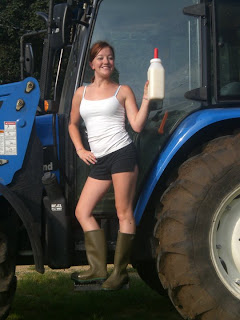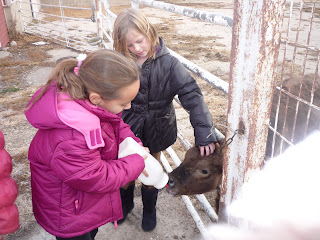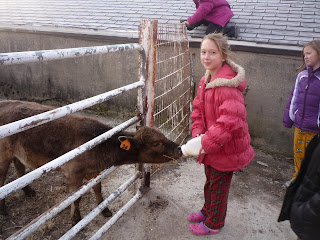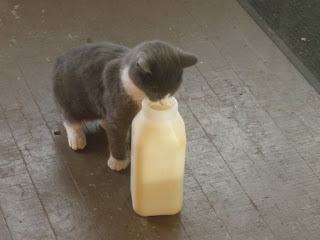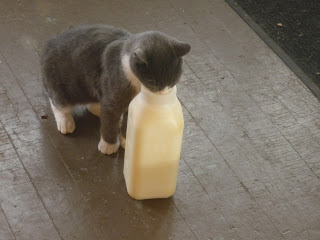Dear Road Construction Victims,
Welcome to my road! I hope you enjoy your new route to the outside world and that it be most temporary. I understand that detours have the ability to adversely affect your life in the form of longer commutes, lack of turn lanes, and low shoulders. Please allow me to give you a short orientation to my road, in the hopes of improving your experience.
1. My road is extremely picturesque, please enjoy the view.
2. On the West side, among others, you will see undulating fields, cattle dotting the hillsides, a few mules (look hard!), a barn with the flag painted on the side, and some quaint, broken down, rusty old farm equipment deposited oh-so-lovingly in someone’s field.
3. To the East side, among others, you’ll see a round barn, some chickens, a shelter-house, a horse farm or two, as well as the requisite undulating fields and cattle dotting the hillsides.
4. If you happen to have car trouble, don’t panic. A friendly farmer will be along shortly to help you.
5. Please don’t flip that same farmer off as you pass him/her at 80 mph tomorrow morning when you’re late for work.
6. You are lucky to be driving through the rolling hill country of Illinois. A few 20 miles south of here, it’s flat for as far as the eyes can see.
7. On that note, I’ll make the respectful request that you don’t pass me on the uphill when I’m on the way to move cows, driving the farm ATV.
8. Yes, it’s legal to drive farm-related ATV’s on the road.
9. No, it’s not fun to off-road it when you’re loaded down with fence posts, electric wire, and a 50-lb. bag of salt/mineral blend.
10. This area of the country is called the Heartland, not the Wasteland. The bread basket of the world, not the waste basket of the world. Get my drift?
11. Ahhh, it’s harvest time. What a wonderful time of year. You have the unique opportunity to observe, up-close and personal, how our nation’s crops are harvested. Take advantage of it!
12. You also have the unique opportunity to be squashed into an accordion by a random bale-mover crossing the road if you decide you can text and drive on our quiet route.
13. WARNING: There are farm implements, attachments, and trailers sticking out, parked along, and blocking the road entirely at any and all random times and locations throughout harvest season.
14. Rural people are friendly. We’re also isolated. I know you had a bad day at work, but put it behind you and wave at us, for Pete’s sake.
15. Oh, this one is important! Rural people in cars wave by raising their pointer finger off the steering wheel.
16. Yes, we’re raising a finger at you.
17. No, not that one.
18. I know you’re frustrated that you can’t get to work on the main thoroughfare and I’m so sorry for your inconvenience.
19. Our stop signs are not optional.
20. We love to have people stop by and visit our farm animals.
21. Not all farmers feel the same way. Ask first.
22. Which reminds me: the fences are electrified, the horses and goats can bite, yes, that’s a bull in the pasture, you might get some chicken and/or cow poop on the bottom of your shoes, and we have rusty nails galore. Keep your wits about you and don’t sue me if you or your kids do something foolish.
23. We try our best to keep the chickens out of the road, we really do. They have wings. Enough said.
24. Please don’t go bowling for chickens.
25. The speed limit is 55. Not 65, not 75, and certainly not 85. Please SLOW DOWN.
26. If a farmer is pulling a wagon loaded with grain, s/he absolutely can’t pull off to the side to let you pass.
27. We also really don’t enjoy holding up that long line of cars behind us.
28. Unless you’re one of those who flipped us off while passing us at 80 mph. Then we do.
29. Farmers love to flag down other farmers, idle in our pick up trucks in the middle of the road, ideally at a corner or on a blind hill, block traffic, and chat about the corn yields over coffee in styrofoam cups.
30. You should try it sometime.
31. Finally, farmers know that manure stinks.
32. If you don’t slow down, a random farmer might just lay a strip of that stinky manure down the center of the road.
Well! I’m so glad I’ve had this opportunity to show off my Midwestern hospitable nature. Once again, enjoy the drive and rural scenery. Soon enough you’ll be back to your regular route and our quaint little farm road will be but a distant memory. Until then, be well and have a wonderful day!
Most sincerely yours,
The Farmer



